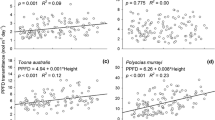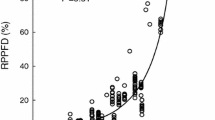Abstract
Trees reduce their allocation to apical growth compared with that to radial growth during later life stages. This has often been attributed to hydraulic and mechanical limitations; however, a growth–reproduction tradeoff might also play an important role. To test whether the height–diameter (H–D) relationship in trees changes with the timing of the onset of reproduction, we analyzed the H–D relationship of 13 deciduous broad-leaved tree species in a Japanese old-growth temperate forest using linear and segmented-linear regression models. These models showed a better fit than common continuous models (simple allometry and saturating curve). For 11 out of 13 species having break points on the H–D lines, we assessed whether the height at the breakpoint (BPH) was related to the height at the onset of reproduction determined by multiyear observatory records on several trees. Although BPH estimates for these 11 species were highly variable, most were within 3.1 m of the stable flowering height (staFLH), or the height at which trees achieve the ability to flower regardless of their growth conditions. The interspecies mean value of the difference between staFLH and BPH was only 45 cm, which suggested a causal relationship between these parameters. BPHs of nine out of 11 species were within the canopy layer and, for the two remaining species, were within the subcanopy layer. These results suggest that several species in this forest begin to reduce their allocation to apical growth around the canopy layer at the onset of stable reproduction.



Similar content being viewed by others
References
Aiba M, Nakashizuka T (2009) Architectural differences associated with adult stature and wood density in 30 temperate tree species. Funct Ecol 23:265–273. https://doi.org/10.1111/j.1365-2435.2008.01500.x
Antin C, Pélissier R, Vincent G, Couteron P (2013) Crown allometries are less responsive than stem allometry to tree size and habitat variations in an Indian monsoon forest. Trees - Struct Funct 27:1485–1495. https://doi.org/10.1007/s00468-013-0896-7
Banin L, Feldpausch TR, Phillips OL, Baker TR, Lloyd J, Affum-Baffoe K, Arets EJ, Berry NJ, Bradford M, Brienen RJ, Davies S, Drescher M, Higuchi N, Hilbert DW, Hladik A, Iida Y, Salim KA, Kassim AR, King DA, Lopez-Gonzalez G, Metcalfe D, Nilus R, Peh KS, Reitsma JM, Sonké B, Taedoumg H, Tan S, White L, Wöll H, Lewis SL (2012) What controls tropical forest architecture? Testing environmental, structural and floristic drivers. Global Ecol Biogeogr 21:1179–1190. https://doi.org/10.1111/j.1466-8238.2012.00778.x
Beckage B, Joseph L, Belisle P, Wolfson DB, Platt WJ (2007) Bayesian change-point analyses in ecology. New Phytol 174:456–467. https://doi.org/10.1111/j.1469-8137.2007.01991.x
Blanchard E, Birnbaum P, Ibanez T, Boutreux T, Antin C, Ploton P, Vincent G, Pouteau R, Vandrot H, Hequet V, Barbier N, Droissart V, Sonké B, Texier N, Kamadem NG, Zebaze D, Libalah M, Couteron P (2016) Contrasted allometries between stem diameter, crown area, and tree height in five tropical biogeographic areas. Trees—Struct Funct 30:1953–1968. https://doi.org/10.1007/s00468-0161424-3
Chave J, Réjou-Méchain M, Búrquez A et al (2014) Improved allometric models to estimate the aboveground biomass of tropical trees. Global Change Biol 20:3177–3190. https://doi.org/10.1111/gcb.12629
Davies SJ, Ashton PS (1999) Phenology and fecundity in 11 sympatric pioneer species of Macaranga (Euphorbiaceae) in Borneo. Amer J Bot 86:1786–1795. https://doi.org/10.2307/2656675
Day ME, Greenwood MS (2011) Regulation of ontogeny in temperate conifers. In: Meinzer FC, Lachenbruch B, Dawson TE (eds) Size- and age-related changes in tree structure and function. Springer, Dordrecht, pp 91–120
Gross HL (1972) Crown deterioration and reduced growth associated with excessive seed production by birch. Can J Bot 50:2431–2437. https://doi.org/10.1139/b72-312
Harshman LG, Zera AJ (2006) The cost of reproduction: the devil in the details. Trends Ecol Evol 22:80–86. https://doi.org/10.1016/j.tree.2006.10.008
Hsu C-Y, Adams JP, Kim H, No K, Ma C, Strauss SH, Drnevich J, Vandervelde L, Ellis JD, Rice BM, Wickett N, Gunter LE, Tuskan GA, Brunner AM, Page GP, Barakat A, Carlson JE, dePamphilis CW, Luthe DS, Yuceer C (2011) FLOWERING LOCUS T duplication coordinates reproductive and vegetative growth in perennial popular. Proc Natl Acad Sci USA 108:10756–10761. https://doi.org/10.1073/pnas.1104713108
Ichie T, Kenzo T, Kitahashi Y, Koike T, Nakashizuka T (2005) How does Dryobalanops aromatica supply carbohydrate resources for reproduction in a masting year? Trees—Struct Funct 19:703–710. https://doi.org/10.1007/s11284-011-0836-1
Iida Y, Kohyama TS, Kubo T, Kassim AR, Poorter L, Sterck R, Potts MD (2011) Tree architecture and life-history strategies across 200 co-occurring tropical tree species. Funct Ecol 25:1260–1268. https://doi.org/10.1111/j.1365-2435.2011.01884.x
Innes JL (1994) The occurrence of flowering and fruiting on individual trees over 3 years and their effects on subsequent crown condition. Trees—Struct Funct 8:139–150. https://doi.org/10.1007/BF00196638
Ishihara MI, Kikuzawa K (2009) Annual and spatial variation in shoot demography associated with masting in Betula grossa: comparison between mature trees and saplings. Ann Bot 104:1195–1205. https://doi.org/10.1139/b04-099
Ishii H, Jennings G, Sillett S, Koch G (2008) Hydrostatic constraints on morphological exploitation of light in tall Sequoia sempervirens trees. Oecologia 156:751–763. https://doi.org/10.1007/s00442-008-1032-z
Ishii H, Takashima A, Makita N, Yoshida S (2010) Vertical stratification and effects of crown damage on maximum tree height in mixed conifer-broadleaf forests of Yakushima Island, southern Japan. Plant Ecol 211:27–36. https://doi.org/10.1007/s11258-010-9768-z
Kato E, Hiura T (1999) Fruit set in Styrax obassia (Styracaceae): the effect of light availability, display size, and local floral density. Am J Bot 86:495–501. https://doi.org/10.2307/2656810
King D (1996) Allometry and life history of tropical trees. J Trop Ecol 12:25–44. https://doi.org/10.1017/S0266467400009299
King DA (2011) Size-related changes in tree proportions and their potential influence on the course of height growth. In: Meinzer FC, Lachenbruch B, Dawson TE (eds) Size- and age-related changes in tree structure and function. Springer, Dordrecht, pp 165–192
King DA, Davies SJ, Nur Sapardi MN (2006) Growth and mortality are related to adult tree size in a Malaysian mixed dipterocarp forest. Forest Ecol Manag 223:152–158. https://doi.org/10.1016/j.foreco.2005.10.066
Koch GW, Sillett SC, Jennings GM, Davis SD (2004) The limits to tree height. Nature 428:851–854. https://doi.org/10.1038/nature02417
Kohyama T (1993) Size-structured tree populations in gap-dynamic forest - the forest architecture hypothesis for the stable coexistence of species. J Ecol 81:131–143. https://doi.org/10.2307/2261230
Kohyama T, Takada T (2009) The stratification theory for plant coexistence promoted by one-sided competition. J Ecol 97:463–471. https://doi.org/10.1111/j.1365-2745.2009.01490.x
Kohyama T, Suzuki E, Partomihardjo T, Yamada T, Kubo T (2003) Tree species differentiation in growth, recruitment and allometry in relation to maximum height in a Bornean mixed dipterocarp forest. J Ecol 91:797–806. https://doi.org/10.1046/j.1365-2745.2003.00810.x
Masaki T (1993) Life history traits and population dynamics of Cornus controversa; the evaluation of avian seed-dispersal system. Dissertation, Department of Agriculture, The University of Tokyo, Bunkyo-ku Tokyo, Japan
Masaki T (2002) Structure and dynamics. In: Nakashizuka T, Matsumoto Y (eds) Diversity and interaction in a temperate forest community: Ogawa Forest Reserve of Japan. Springer, Berlin, pp 53–55
Masaki T, Suzuki W, Niiyama K, Iida S, Tanaka H, Nakashizuka T (1992) Community structure of a species-rich temperate forest, Ogawa Forest Reserve, central Japan. Vegetatio 98:97–111. https://doi.org/10.1007/BF00045549
Masaki T, Nakashizuka T, Niiyama K, Tanaka H, Iida S (2017) Height–diameter relationships of 29 tree species. Bull FFPRI 16:121–142. https://doi.org/10.20756/ffpri.16.2_121
McMahon TA, Kronauer RE (1976) Tree structure: deducing the principle of mechanical design. J Theor Biol 59:443–466. https://doi.org/10.1016/0022-5193(76)90182-X
Meinzer FC (2003) Functional convergence in plant responses to the environment. Oecologia 134:1–11. https://doi.org/10.1007/s00442-002-1088-0
Miyata R, Kubo T, Nabeshima E, Kohyama T (2011) Common allometric response of open-grown leader shoots to tree height in co-occurring deciduous broadleaved trees. Ann Bot 108:1279–1286. https://doi.org/10.1093/aob/mcr228
Miyazaki Y, Hiura T, Kato E, Funada R (2002) Allocation of resources to reproduction in Styrax obassia in a masting year. Ann Bot 89:767–772. https://doi.org/10.1093/aob/mcf107
Mizoguchi Y, Morisawa T, Ohtani Y (2002) Climate in Ogawa Forest Reserve. In: Nakashizuka T, Matsumoto Y (eds) Diversity and interaction in a temperate forest community: Ogawa Forest Reserve of Japan. Springer, Berlin, pp 11–18
Moncrieff GR, Chamaillé-Jammes S, Higgins SI, O’Hara RB, Bond WJ (2011) Tree allometries reflect a lifetime of herbivory in an African savanna. Ecology 92:2310–2315. https://doi.org/10.1890/11-0230.1
Muggeo V (2008) Segmented: an R Package to fit regression models with broken-line relationships. R News 8/1: 20–25. URL: https://cran.r-project.org/doc/Rnews/Rnews_2008-1.pdf (Accessed 21 Sep 2018)
Niinemets Ü, Cescatti A, Christian R (2004) Constraints on light interception efficiency due to shoot architecture in broad-leaved Nothofagus species. Tree Physiol 24:617–630. https://doi.org/10.1093/treephys/24.6.617
Niinemets Ü, Sparrow A, Cescatti A (2005) Light capture efficiency decreases with increasing tree age and size in the southern hemisphere gymnosperm Agathis australis. Trees—Struct Funct 19:177–190. https://doi.org/10.1007/s00468-004-0379-y
Niklas K (1995) Size-dependent allometry of tree height, diameter and trunk-taper. Ann Bot 75:217–227. https://doi.org/10.1006/anbo.1995.1015
Ogawa H, Yoda K, Ogino K, Kira T (1965) Comparative ecological studies on three main types of forest vegetation in Thailand. II. Plant biomass. Nature Life Southeast Asia 4:49–80
Paul LK, Rinne PLH, van der Schoot C (2014) Shoot meristems of deciduous woody perennials: self-organization and morphogenetic transitions. Curr Opin Plant Biol 17:86–95
Poorter L, Bongers L, Bongers F (2006) Architecture of 54 moist-forest tree species: traits, trade-offs, and functional groups. Ecology 87:1289–1301. https://doi.org/10.1890/0012-9658(2006)87%5b1289:aomtst%5d2.0.co;2
Reekie E (1997) Trade-offs between reproduction and growth influence time of reproduction. In: Bazzaz F, Grace J (eds) Plant resource allocation. Academic press, US, pp 191–209
Ryan M, Phillips N, Bond B (2006) The hydraulic limitation hypothesis revisited. Plant, Cell Environ 29:367–381. https://doi.org/10.1111/j.1365-3040.2005.01478.x
Satake Y, Hara H, Watari S, Tominari T (eds) (1989) Wild flowers of Japan. Woody plants, Heibonsha, Tokyo, Japan (In Japanese)
Shibata M, Tanaka H (2002) Reproductive traits of trees of OFR. In: Nakashizuka T, Matsumoto Y (eds) Diversity and interaction in a temperate forest community: Ogawa Forest Reserve of Japan. Springer, Berlin, pp 95–108
Shinozaki K, Yoda K, Hozumi K, Kira T (1964) A quantitative analysis of plant form-the pipe model theory: I. Basic analyses. Jap J Ecol 14:97–105. https://doi.org/10.18960/seitai.14.3_97
Simpson GG, Gendall AR, Dean C (1999) When to switch to flowering. Annu Rev Cell Dev Bi 99:519–550. https://doi.org/10.1146/annurev.cellbio.15.1.519
Suzuki W (2002) Forest vegetation in and around Ogawa Forest Reserve in Relation to Human Impact. In: Nakashizuka T, Matsumoto Y (eds) Diversity and interaction in a temperate forest community: Ogawa Forest Reserve of Japan. Springer, Berlin, pp 27–41
Tanaka H, Nakashizuka T (1997) Fifteen years of canopy dynamics analyzed by aerial photographs in a temperate deciduous forest, Japan. Ecology 78:612–620. https://doi.org/10.1890/0012-9658(1997)078%5b0612:fyocda%5d2.0.co;2
Tanaka H, Shibata M, Masaki T, Iida S, Niiyama K, Abe S, Kominami Y, Nakashizuka T (2008) Comparative demography of three coexisting Acer species in gaps and under closed canopy. J Veg Sci 19:127–138. https://doi.org/10.3170/2007-8-18342
Thomas S (1996a) Relative size at onset of maturity in rain forest trees: a comparative analysis of 37 Malaysian species. Oikos 76:145–154. https://doi.org/10.2307/3545756
Thomas S (1996b) Asymptotic height as a predictor of growth and allometric characteristics in Malaysian rain forest trees. Am J Bot. https://doi.org/10.1002/j.1537-2197.1996.tb12739.x
Thomas SC (2011) Age-related changes in tree growth and functional biology: the role of reproduction. In: Meinzer FC, Lachenbruch B, Dawson TE (eds) Size- and age-related changes in tree structure and function. Springer, Dordrecht, pp 33–64
Thomas SC, Bazzaz FA (1999) Asymptotic height as a predictor of photosynthetic characteristics in Malaysian rain forest trees. Ecology 80:1607–1622. https://doi.org/10.1890/0012-9658(1999)080%5b1607:ahaapo%5d2.0.co;2
Thomas S, Martin AR, Mycroft EE (2015) Tropical trees in a wind-exposed island ecosystem: height-diameter allometry and size at onset of maturity. J Ecol 103:594–605. https://doi.org/10.1111/1365-2745.12378
Watanabe S (2010) Asymptotic equivalence of Bayes cross validation and widely applicable information criterion in singular learning theory. J Mach Learn Res 11:3571–3594
Westoby M (1998) A leaf-height-seed (LHS) plant ecology strategy scheme. Plant Soil 199:213–227. https://doi.org/10.1023/A:1004327224729
Wood ZT, Peart DR, Palmiotto PA, Kong L, Peart NV (2015) Asymptotic allometry and transition to the canopy in Abies balsamea. J Ecol 103:1658–1666. https://doi.org/10.1111/1365-2745.12465
Woodruff DR, Meinzer FC (2011) Water stress, shoot growth and storage of non-structural carbohydrates along a tree height gradient in a tall conifer. Plant Cell Environ 34:1920–1930. https://doi.org/10.1111/j.1365-3040.2011.02388.x
Wright S, Jaramillo M, Pavon J, Condit R, Hubbell S, Foster R (2005) Reproductive size thresholds in tropical trees: variation among individuals, species and forests. J Trop Ecol 21:307–315. https://doi.org/10.1017/S0266467405002294
Acknowledgements
We are grateful to K. Niiyama and other OFR staff for their contribution to the measurement of tree heights and for sharing the results of their work on the DBH reproductive size. K. Niiyama also provided critical comments on an early draft of this manuscript. M.A.S. thanks T.S. Kohyama, H. Taneda, K. Fukuda, and Y. Shinn-mura for meaningful discussions. This work was partially supported by the Japan Society for the Promotion of Science KAKENHI Grant [Grant numbers JP24247003, JP25241026, and JP15H04517].
Author information
Authors and Affiliations
Contributions
HT, MIS, SI, TN, and TM collected core data of this project; OO collected data of forest structure; MAS conceived the ideas and led the writing of the manuscript; KU and MAS analyzed the data; TM, KU, OO and other authors contributed critically to improve the drafts. All authors gave final approval for publication.
Corresponding author
Ethics declarations
Conflict of interest
The authors declare that they have no conflict of interest.
Ethical approval
This article does not contain any studies with human participants or animals performed by any of the authors.
Additional information
Communicated by Gerardo Avalos.
Electronic supplementary material
Below is the link to the electronic supplementary material.
Rights and permissions
About this article
Cite this article
Suzuki, M., Umeki, K., Orman, O. et al. When and why do trees begin to decrease their resource allocation to apical growth? The importance of the reproductive onset. Oecologia 191, 39–49 (2019). https://doi.org/10.1007/s00442-019-04477-y
Received:
Accepted:
Published:
Issue Date:
DOI: https://doi.org/10.1007/s00442-019-04477-y




